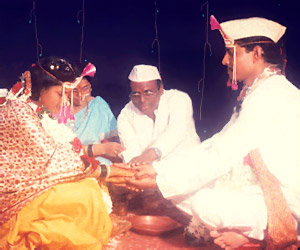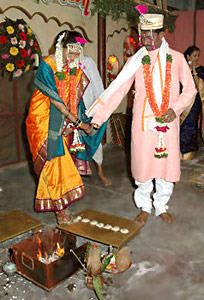 The actual marriage ceremony starts with a muhurta patra that is set up to measure and maintain the time before the auspicious moment of the marriage. Drop by drop, the water trickles down counts the seconds while the bride, ready and dressed in a yellow or green sari and a half moon painted on her forehead for luck, worships Goddess Parvati, who is the goddess of marital bliss in an anteroom until she is asked to come onto to the dais.
The actual marriage ceremony starts with a muhurta patra that is set up to measure and maintain the time before the auspicious moment of the marriage. Drop by drop, the water trickles down counts the seconds while the bride, ready and dressed in a yellow or green sari and a half moon painted on her forehead for luck, worships Goddess Parvati, who is the goddess of marital bliss in an anteroom until she is asked to come onto to the dais.
The venue is decorated with flowers and a havan is prepared. The priest sits on the north direction of the altar, the bride sits on his right and groom sits on his left. As the propitious time for the wedding approaches, the brides` mother brings her to the mandap. The approach to the mandap is indeed an intricate one as they bride and the groom are not permitted to see each other again.
Seemaan Pooja: After the grooms` procession arrives at the bride`s place, a seemaan pooja is performed. This is when the bride`s parents wash the feet of the groom and his parents and conventionally welcome the folks of his family. The groom is given gifts by the parents of the bride. These usually include ring, watch, gold chain and others.
Sannkalp: The groom shows his wish to enter a life of a householder. The priest thus blesses him and ensures that his desire will be fulfilled. The bride and the groom ask for the blessing and consent of the elders to marry, which is granted and they are gifted with clothes, jewellery etc. The parents of the either parties greet each other and they are given madhuparka, which is a kind of fruit salad with honey, yogurt, ghee and milk.
Kanyadaan: The bride`s father offers her hand in the hands of the groom. The mother of the bride pours water into the palms of the couple. This is a symbol that the father of the bride has offered his daughter to the Groom. The groom then holds the right shoulder of the bride in the gesture of acceptance. The groom then assures the bride`s father that he will be truthful and will take care of his wife for the rest of his life.
Mangalsutra Bandhan: The groom ties the mangalsutra around the neck of the bride. Mangal sutra is a necklace made up of golden pendant and black beads with alternative gold ones. This is believed to be a married woman`s most precious possession. The groom then applies kumkum on the forehead of the bride and she in turn applies a tilak made of sandalwood paste on the forehead of her husband. The grooms mother gifts the bride a silk sari, along with toe rings etc. The bride then comes back to the mandap after changing in to the new sari as an acceptance into her in-laws household.
Vivah Homa: The priest lights the fire in the altar and a stone is kept facing the west, a pitcher filled with water to the northeast, four kusha or grass blades, are spread to the northern direction of the fire. On them two small metal bowls containing ghee is placed. One of these pitchers is to be filled with water and the other with ghee melted in the fire. The priest then lights fire that is called yajoka. The groom then takes two darbhas, dips them into the bowl of water, and sprinkles them over the ghee and around the fire. This is a purifying sign. Then he offers the pavitrika of the darbhas to the fire in the name of Skanda, the heroic deity. He takes the jug of ghee and pours a portion into the fire as surrendering to Prajapati, the God of creation.
 Satpadhi: This is the ritual where the two walk together the seven steps. The groom takes the left hand of the bride in his right hand and they take seven steps together in the southeast direction. A heap of rice is kept at every step and the couple step on this heap at every step. The ritual is symbolic of their married life and is an exchange of vows between them. At the end of the ritual the groom chants mantras to forgive him for any flaws in the conduct of the homa.
Satpadhi: This is the ritual where the two walk together the seven steps. The groom takes the left hand of the bride in his right hand and they take seven steps together in the southeast direction. A heap of rice is kept at every step and the couple step on this heap at every step. The ritual is symbolic of their married life and is an exchange of vows between them. At the end of the ritual the groom chants mantras to forgive him for any flaws in the conduct of the homa.
Praneetapatra is a large container of water known, as is taken around the fire in an anti clockwise direction, after which the water is sprinkled in all direction and also on the heads of the bride and the groom. The seven steps across the sacred fire is the most common ritual in all Hindu marriages.
Marriage Ceremony: At long last, the swastik-marked antarpat or the white cloth is held up between the couple. Her maternal uncle brings the bride to the dais and the mangalashtakas or the eight blessings are chanted. When the recitation is over, the cloth is removed amidst a crescendo of shehnais and the bride and groom exchange garlands called varmalas. This is also the `darshan` of a bride and groom for the first time as man and wife. At the time of removing the Antarpaat, the people attending the wedding shower the couple with Akshata or unbroken rice. It is essential that the grains should be whole, as they are symbolic of the blessing from the attendees. The couple garlands each other. Alike most Hindu marriages seven rounds around the havan are called the Saptapadi.
Laxmi Narayan Puja: One of the most significant events after the marriage is Laxmi Narayan Puja. The bride and the bridegroom are considered to be Goddess Laxmi and Lord Narayan respectively and worshipped. After this ceremony the bride is properly handed over by her parents to the bridegroom in a ceremony called kanyadaan.
Karmasamapti: This ritual indicates the conclusion of the ceremony. The bride`s father is the one who concludes the marriage ceremony. He takes water from his left hand and passes it over to his right hand, chanting a mantra, which appeases the Gods, so that they shower blessings on the wedding of his daughter. The bride and the groom ask God to bless their marriage.
Grihapravesh: The groom`s mother welcomes the couple. She washes the couple`s feet with milk and then water. After the aarti is performed, the bride enters the house by kicking a glass of rice. The couple enters the house putting their right foot forward. The family sits and talks for sometime after which the couple is shown their room.
More on Maharashtrian Wedding
More on Marriage System in Indian States
More on Indian Wedding Accessories
More on Indian Religious Weddings
More on Types of Marriages
See also
 The actual marriage ceremony starts with a muhurta patra that is set up to measure and maintain the time before the auspicious moment of the marriage. Drop by drop, the water trickles down counts the seconds while the bride, ready and dressed in a yellow or green sari and a half moon painted on her forehead for luck, worships Goddess Parvati, who is the goddess of marital bliss in an anteroom until she is asked to come onto to the dais.
The actual marriage ceremony starts with a muhurta patra that is set up to measure and maintain the time before the auspicious moment of the marriage. Drop by drop, the water trickles down counts the seconds while the bride, ready and dressed in a yellow or green sari and a half moon painted on her forehead for luck, worships Goddess Parvati, who is the goddess of marital bliss in an anteroom until she is asked to come onto to the dais.
 Satpadhi: This is the ritual where the two walk together the seven steps. The groom takes the left hand of the bride in his right hand and they take seven steps together in the southeast direction. A heap of rice is kept at every step and the couple step on this heap at every step. The ritual is symbolic of their married life and is an exchange of vows between them. At the end of the ritual the groom chants mantras to forgive him for any flaws in the conduct of the homa.
Satpadhi: This is the ritual where the two walk together the seven steps. The groom takes the left hand of the bride in his right hand and they take seven steps together in the southeast direction. A heap of rice is kept at every step and the couple step on this heap at every step. The ritual is symbolic of their married life and is an exchange of vows between them. At the end of the ritual the groom chants mantras to forgive him for any flaws in the conduct of the homa.

















